ITALY 2008
Day
6, Monday, May 12
SIECI AND
FLORENCE
We got up at 7:30
am. Mike and Mary came over to our
apartment about 9:00. We went with
them to Sieci, which was on the other side of the mountain from Fiesole for
breakfast. We had driven into Sieci
when we arrived from Ravenna. The eatery where Mike and Mary usually ate
breakfast was closed but we found another restaurant in a hotel where we had
coffee and pastries on a covered terrace/porch.
Our plan was to visit the dentist that owner of our villa had told us
around. We finally found the
building but none of the offices were open.
We waited around for a while and decided to go back home.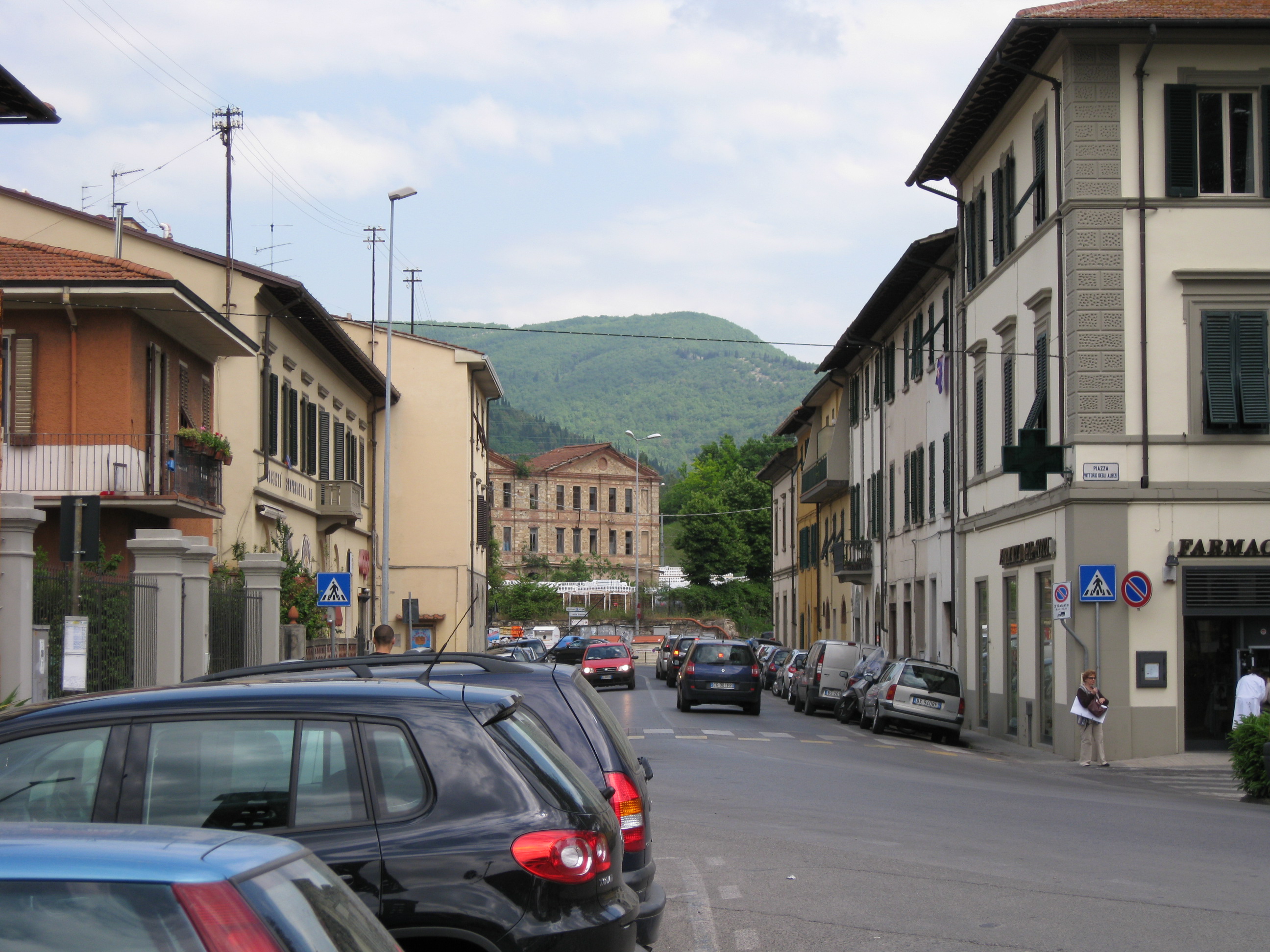
Sieci is a nice
little town on the banks of the Arno River, the river which run through
Florence. The town itself is only
one or two streets wide. The main
street, which is the main road for the area is not vary wide but affords parking
spaces on both side in front of the local stores.
The dentist’s office, which we will visit twice more, was towards the
side of a beautiful little town park. There
were many trees in the park and nice benches.
We sat there waiting for the dentist office to open.
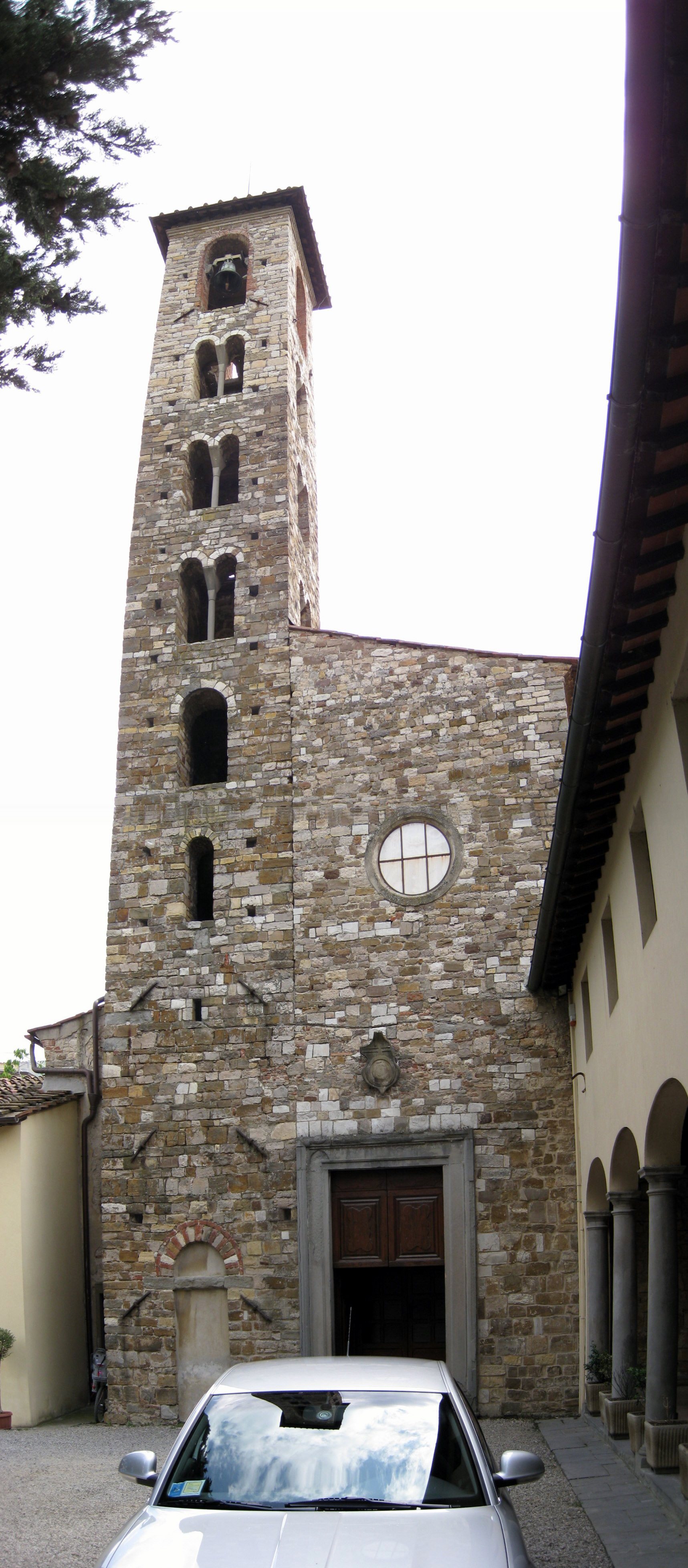
Across the street was a church with a very high bell tower.
I went over to explore it and take photos. I couldn’t find out much
about the church, but since have located a webpage for it.
The name of the church is S. Giovanni Battista a Remole
(St. John the
Baptist of Romulus). There
are documents claiming the church goes back to 935.
During
the
13th
century, the church was enlarged which transformed the building to three aisles
which is the way it is now.

The
interior was decorated with various works of art among which the Madonna and
child that goes back to this period.
In
1740 a
disastrous
flood caused considerable damage to the church. During the nineteenth century
Sieci grew larger, thanks to the brick industry which gave employment to many
families. The population grew nearly four times going from 625 inhabitants in
1825 to 2100 of the 20's of 1900. We
enjoyed our stay there.
We came back to the villa, and did a
little washing. Mike and Mary wanted
to stay home so we went back to Fiesole to catch the bus for Florence.
We had a hard time finding a parking place.
We got on a little narrow road from
one of the parking lots that was filled. The
further we went on this road the narrower the road became.
It was one way – we hoped we did no t meet an oncoming car as there was
no place to pull over. It was pretty scary.
We had no idea where we were but our GPS kept giving directions. We
finally got back to
Fiesole and found a parking place. We
caught the bus to Florence.
t meet an oncoming car as there was
no place to pull over. It was pretty scary.
We had no idea where we were but our GPS kept giving directions. We
finally got back to
Fiesole and found a parking place. We
caught the bus to Florence.

We went to
Santa
Maria Novella. The Gothic Church of
Santa Maria Novella contains some of the most important works of art in
Florence. The present church was
built in 1279, finished in 1357 by the Dominicans.
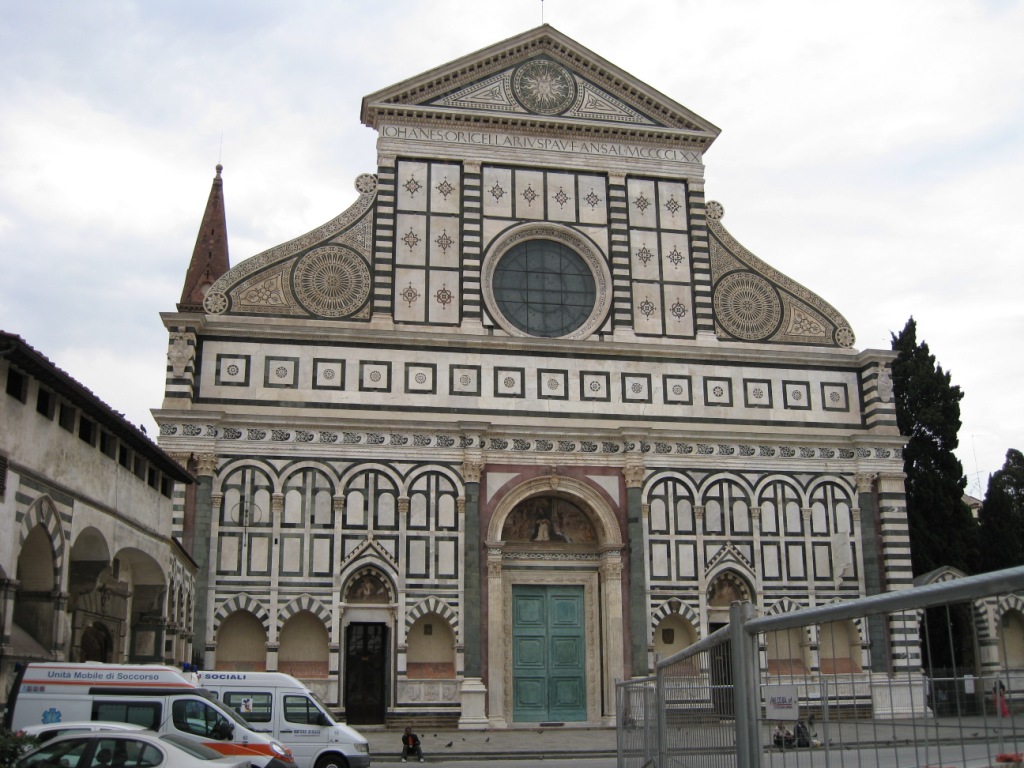
The façade was
started in 1350 and finished in 1470.
The architect, Leone Battista Alberti, framed the lower portion with side
pilasters and four columns. The
large door is enclosed in an arch. Separating the
bottom of the façade from the top is a wide horizontal strip decorated with
square inlay. Above this
strip is a
large circular window which is flanked on either side by two circular designs.
The façade is topped by a triangular pediment.
It was interesting to look at the façade from the side and see how it
had been added to the former brick façade.
 The interior was
magnificent. It was built as a three
aisle basilica with trancept and five square chapels.
It is said to be one of the most important examples of a Late Gothic
interior in Europe. The
arcades are very wide. All of the
columns are dark stone while all of the arches display a border of alternating
dark and light stone- even the arches in the vaulted ceiling.
The nave piers are spaced closer at the east end to create the
illusion of an exceptional long church. We saw many of the paintings that we had
seen on the Teaching Company Lectures on Renaissance Art,
especially Masaccio’s Trinity and Giotto’s crucifix.
The interior was
magnificent. It was built as a three
aisle basilica with trancept and five square chapels.
It is said to be one of the most important examples of a Late Gothic
interior in Europe. The
arcades are very wide. All of the
columns are dark stone while all of the arches display a border of alternating
dark and light stone- even the arches in the vaulted ceiling.
The nave piers are spaced closer at the east end to create the
illusion of an exceptional long church. We saw many of the paintings that we had
seen on the Teaching Company Lectures on Renaissance Art,
especially Masaccio’s Trinity and Giotto’s crucifix.
Masaccio’s Trinity
is one of the first works in which the painter devoted his attention to the laws
of linear perspective which had been recently developed by Brunelleschi.
The impression of a space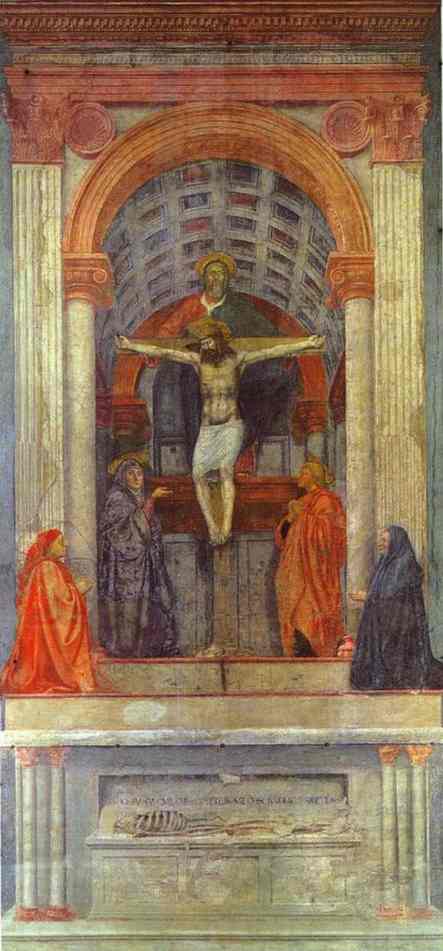 extending back into the wall is created through
the depiction of the coffered arch ceiling.
God the Father dominates the crucifix with the Christ figure in the
center. The Holy Spirit is as a dove
over the head of Jesus and beneath of chin of God the Father.
Mary and Joseph are shown kneeling at the side of the cross.
The three dimensional effect continues with two patrons kneeling on a
step below like a room in front. The
bottom of the fresco, also in perspective, is a tomb with a skeleton on top.
There is the following inscription of the tomb:” I was what you are,
you will be what I am”.
extending back into the wall is created through
the depiction of the coffered arch ceiling.
God the Father dominates the crucifix with the Christ figure in the
center. The Holy Spirit is as a dove
over the head of Jesus and beneath of chin of God the Father.
Mary and Joseph are shown kneeling at the side of the cross.
The three dimensional effect continues with two patrons kneeling on a
step below like a room in front. The
bottom of the fresco, also in perspective, is a tomb with a skeleton on top.
There is the following inscription of the tomb:” I was what you are,
you will be what I am”.
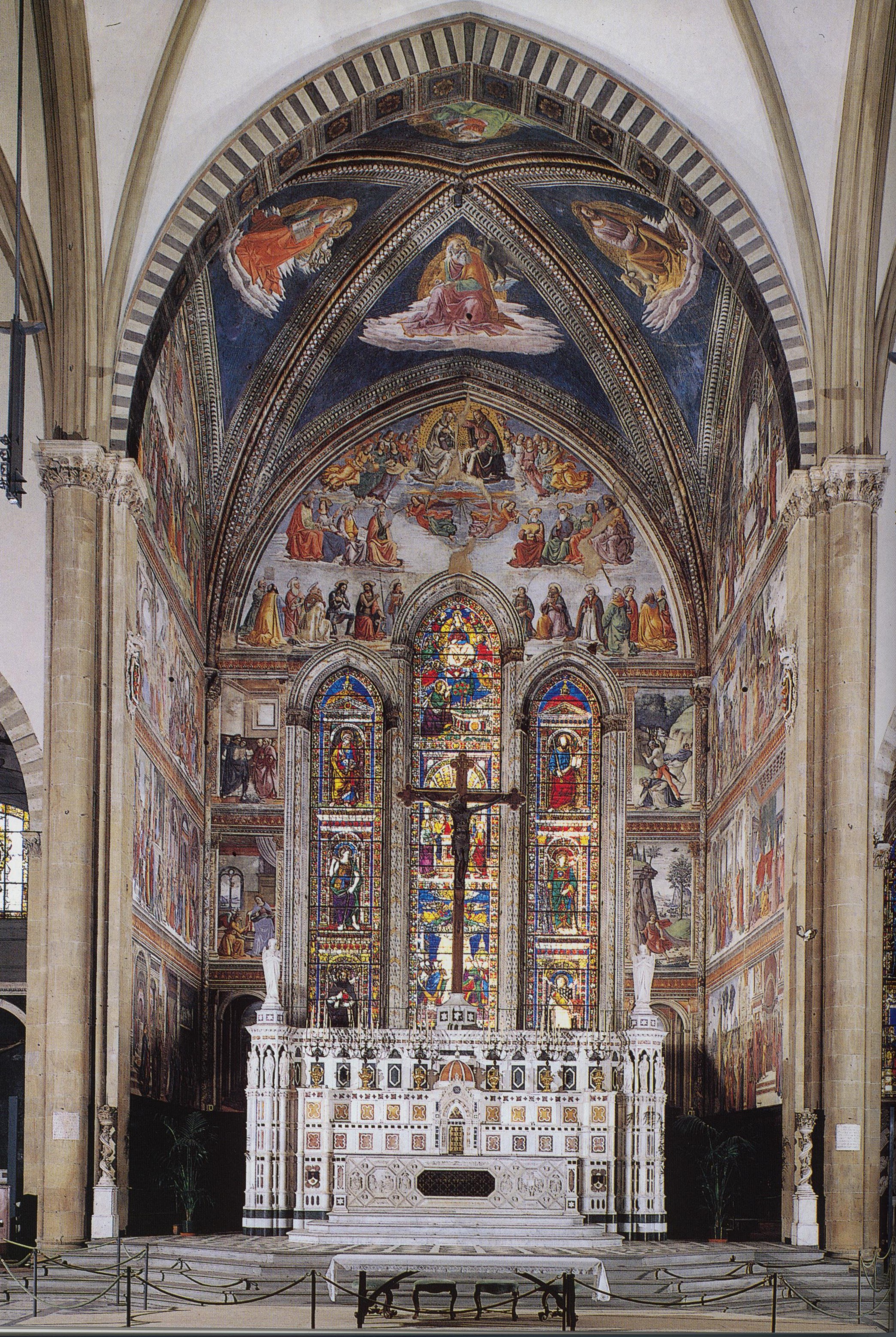
There are four
famous chapels in Santa Maria Novella. The
Tornabuoni Chapel – in 1485 Domenico Ghirlandaio was commissioned by banker
Giovanni Torabuoni to paint this chapel. The
walls were frescoed with the events from the lives of Mary and St. John.
We had studied these paintings during the Teaching Company lecture.
Among the most noted panels were the Birth of the Virgin and the Birth of
John the Baptist.
Another chapel with
beautiful frescos is the Filippo Strozzi Chapel.
It was donated by banker Filippo Strozzi who commissioned Filippino Lippi
to fresco the walls with episodes from the lives of St. Philip and John the
Baptist.
A third chapel was
donated by Tommaso Strozzi who commissioned the brothers, Nardo and Andrea di
Cione. The main wall depicts the Last Judgment while the two side walls are
scenes from Dante’s Divine Comedy.

The fourth chapel,
the Spanish Chapel, is entered from the Cloister.
The Cloister itself is very interesting with frescos of Noah and the
Flood by Uccello. Unfortunately much
of these paintings were destroyed by the 1966 flood.
The Spanish Chapel had been a Dominican chapter-house by around the mid
14th century. It became
known as the Spanish Chapel when it was dedicated to the use of the Spanish
community in 1556 in honor of the Duchess Eleonora of Toledo.
The entire chapel is frescoed with sections based on a theological theme
which reflects the philosophy of the Dominican order and describes the path of
humans to redemption and salvation. It
was a very moving experience, and we spent a long time absorbing these
magnificent works. There
wasn’t anyone there to tell us not to take photos so I took a picture of each
panel.
It was 4:30 when we
left Santa Maria Novella, and too late to go somewhere else, so we walked back
to the Duomo. The bookstore was open
so we bought a book on the Duomo. We
walked towards to the bus, but found a nice bar where we had a drink before
heading back to Fiesole.
At 5:15, we caught
the bus back to Fiesole. It was an
experience…rush hour…talk about sardines!!
We found that we had had a phone call from Mike about the dentist, but it
was too late to go. Mike and Mary
showed up in Fiesole, and we went to the same restaurant as last night. The
waitress didn’t understand English. Mike
and Mary finished dinner before we got our appetizer. My wife had ordered soup
but when it came it was clams. She
sent it back and got some minestrone soup and gnocchi. I had liver pate on
toast, then mushroom pasta and later breaded veal and fresh fried potatoes.
It was a good meal, but not a fine dining experience. We went back to our
apartment in Monteloro and spent the rest of the evening reading and writing.
Being in the beautiful Santa Maria Novella was an experience that we will
never forget. This is a MUST
stop for anyone visiting Florence, of course, we are going to say that about
every church that we will visit!!!




 t meet an oncoming car as there was
no place to pull over. It was pretty scary.
We had no idea where we were but our GPS kept giving directions. We
finally got back to
Fiesole and found a parking place. We
caught the bus to Florence.
t meet an oncoming car as there was
no place to pull over. It was pretty scary.
We had no idea where we were but our GPS kept giving directions. We
finally got back to
Fiesole and found a parking place. We
caught the bus to Florence.

 The interior was
magnificent. It was built as a three
aisle basilica with trancept and five square chapels.
It is said to be one of the most important examples of a Late Gothic
interior in Europe. The
arcades are very wide. All of the
columns are dark stone while all of the arches display a border of alternating
dark and light stone- even the arches in the vaulted ceiling.
The nave piers are spaced closer at the east end to create the
illusion of an exceptional long church. We saw many of the paintings that we had
seen on the Teaching Company Lectures on Renaissance Art,
especially Masaccio’s Trinity and Giotto’s crucifix.
The interior was
magnificent. It was built as a three
aisle basilica with trancept and five square chapels.
It is said to be one of the most important examples of a Late Gothic
interior in Europe. The
arcades are very wide. All of the
columns are dark stone while all of the arches display a border of alternating
dark and light stone- even the arches in the vaulted ceiling.
The nave piers are spaced closer at the east end to create the
illusion of an exceptional long church. We saw many of the paintings that we had
seen on the Teaching Company Lectures on Renaissance Art,
especially Masaccio’s Trinity and Giotto’s crucifix.
 extending back into the wall is created through
the depiction of the coffered arch ceiling.
God the Father dominates the crucifix with the Christ figure in the
center. The Holy Spirit is as a dove
over the head of Jesus and beneath of chin of God the Father.
Mary and Joseph are shown kneeling at the side of the cross.
The three dimensional effect continues with two patrons kneeling on a
step below like a room in front. The
bottom of the fresco, also in perspective, is a tomb with a skeleton on top.
There is the following inscription of the tomb:” I was what you are,
you will be what I am”.
extending back into the wall is created through
the depiction of the coffered arch ceiling.
God the Father dominates the crucifix with the Christ figure in the
center. The Holy Spirit is as a dove
over the head of Jesus and beneath of chin of God the Father.
Mary and Joseph are shown kneeling at the side of the cross.
The three dimensional effect continues with two patrons kneeling on a
step below like a room in front. The
bottom of the fresco, also in perspective, is a tomb with a skeleton on top.
There is the following inscription of the tomb:” I was what you are,
you will be what I am”. 
